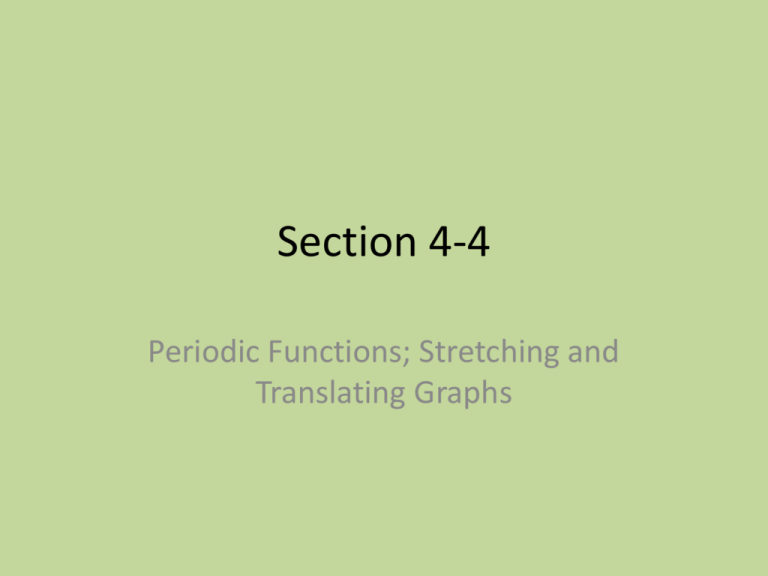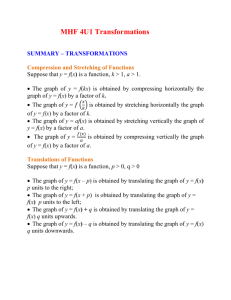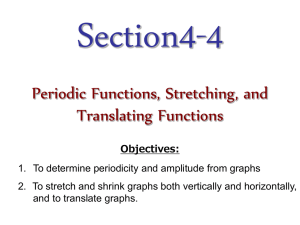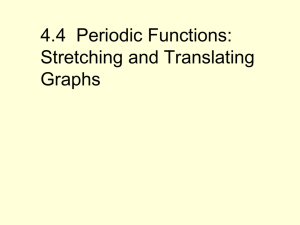Section 4-4 - MrsBarnesTrig
advertisement

Section 4-4 Periodic Functions; Stretching and Translating Graphs Periodic Functions • A function f is periodic if there is a positive number p, called a period of f, such that f(x + p) = f(x) for all x in the domain of f. The smallest period of a periodic function is called the fundamental period of the function. Periodic Functions • The definition of a periodic function implies that if f is a periodic function with period p, then f(x) = f(x + mp) for all x and any integer m. Amplitude • If a periodic function has a maximum value M and a minimum value m, then the amplitude A of the function is given by: A M m 2 Stretching and Shrinking Graphs • The graph of y = cf(x) where c is positive (and not equal to 1) is obtained by vertically stretching or shrinking the graph of y = f(x). The points on the x-axis remain fixed, while all other points move away from the x-axis for c > 1 (a vertical stretch) or toward the x-axis for 0 < c < 1 (a vertical shrink). • Examine graphs p. 140 Stretching and Shrinking Graphs • The graph of y = f(cx) where c is positive (and not equal to 1) is obtained by horizontally stretching or shrinking the graph of y = f(x). The points on the y-axis remain fixed, while all other points move toward the y-axis for c > 1 (a horizontal shrink) or away from the y-axis for 0 < c < 1 (a horizontal stretch). • Examine graphs p. 140 Stretching and Shrinking Graphs • The graphs shown on p. 140 are all based on a periodic function f with fundamental period 4 and amplitude 2. Notice that a vertical stretching or shrinking of the graph of f affects the amplitude but not the period, and a horizontal stretching or shrinking of the graph affects the period but not the amplitude. Changing the Period and Amplitude of a Periodic Function • If a periodic function f has period p and amplitude A, then: • Y = cf(x) has period p and amplitude cA, and • Y=f(cx) has period and amplitude A Translating Graphs • The graph of y – k = f(x – h) is obtained by translating the graph of y = f(x) horizontally h units and vertically k units. • Examine graphs p. 141 If the equation y = f(x) is changed to: Y = -f(x) Y = |f(x)| Then the graph of y = f(x) is: Y = f(-x) X = f(y) Y = cf(x), c > 1 Reflected in the x-axis Unchanged when f(x)>0 and reflected in the x-axis when f(x) < 0 Reflected in the y-axis Reflected in the line y = x Stretched vertically Y = cf(x), 0 < c < 1 Y = f(cx), c > 1 Shrunk vertically Shrunk horizontally Y = cf(x), 0 < c < 1 Stretched horizontally Y – k = f(x – h) Translated h units horizontally and k units vertically Example • Tell whether f appears to be periodic. If so, give its fundamental period and its amplitude, and then find f(1000) and f(1000). Example Use the graph of y = f(x), to sketch the graph of the following. a. Y = 2f(x) b. Y = f(-2x) c. Y = -½f(x) d. Y = f(½x) e. Y = f(x - ½) f. Y = f(-x) + 1



